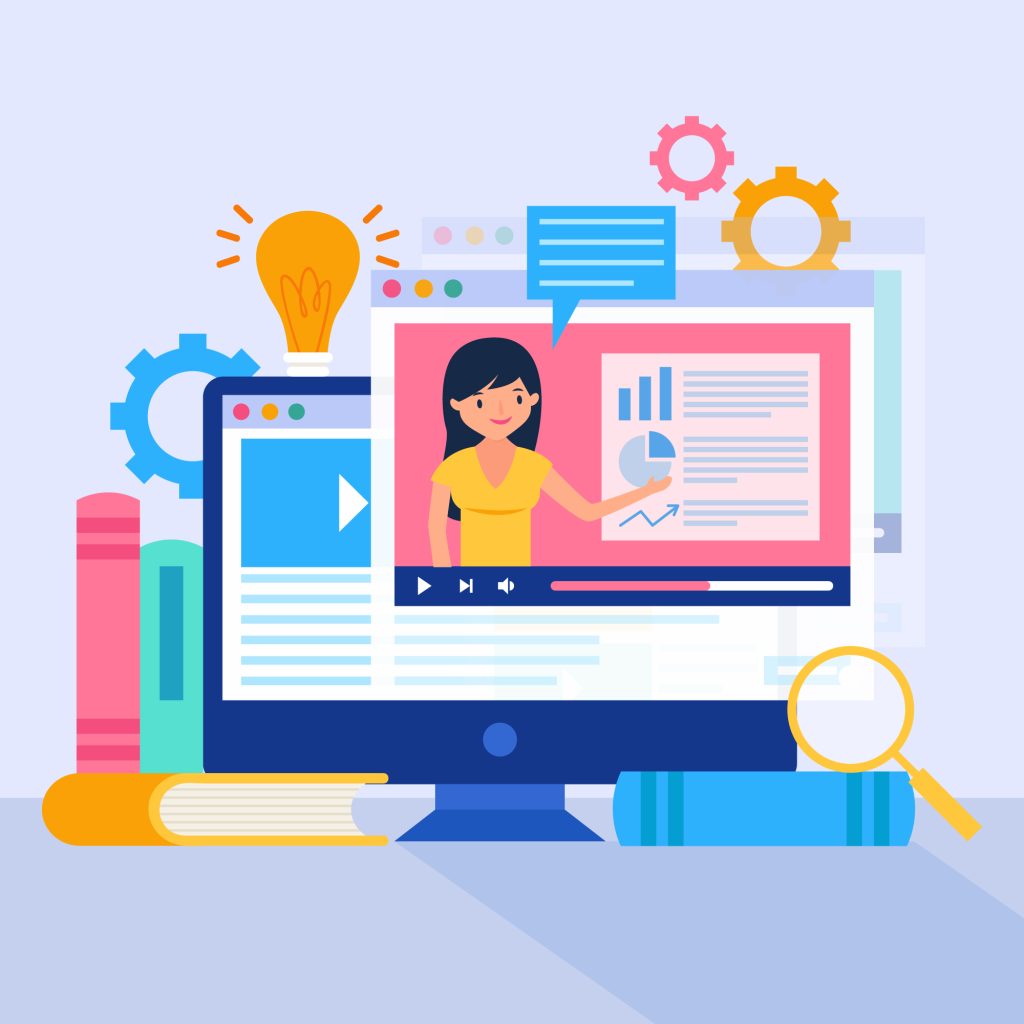Here’s a straightforward way to plan, deliver, and manage educational content that keeps your audience returning for more.
What is a Content Strategy for Online Education?
A content strategy for online education is a plan that outlines the creation, delivery, and management of educational content to engage and inform an online learning community.
- First, you need to set clear goals. What do you want to achieve with your content? Whether it’s increasing engagement, improving learning outcomes, or building a community, having specific objectives will guide your efforts.
- Next, identify your target audience. Knowing who you’re creating content for allows you to tailor your material to meet their needs and preferences. This step involves researching your audience’s demographics, interests, and pain points.
- Then, choose the right formats and channels. Different types of content—videos, articles, quizzes—resonate differently with various audiences. Selecting the right mix ensures your content is both accessible and engaging.
- Finally, measure your content’s effectiveness. Use analytics tools to track engagement, retention, and other key metrics. This data helps you understand what’s working and needs improvement, allowing you to refine your strategy over time.
7 Steps to Create an Engaging Content Strategy for Online Education
Let’s break it down into manageable steps. For actionable ideas, explore these proven tactics to grow engagement.
1. Define Your Goals and Objectives
Start by setting clear goals and objectives for your content strategy. What do you want to achieve? Whether it’s increasing engagement, improving learning outcomes, or building a stronger community, having specific targets will guide your efforts. Outline both short-term and long-term goals. Short-term goals include increasing course completion rates, while long-term goals could focus on expanding your community or enhancing brand loyalty.
2. Identify Your Target Audience
Understanding your audience is key to creating relevant content. Identify who your learners are, what they need, and how they prefer to consume information. Gather data on demographics, interests, and pain points. Use surveys, feedback forms, and analytics tools to comprehensively view your audience. Knowing your audience helps tailor your content to meet their needs and preferences, making it more engaging and effective.
3. Conduct a Content Audit
Review your existing content to see what’s working and what’s not. A content audit helps you identify gaps, redundancies, and opportunities for improvement. List all your current content, categorize it, and evaluate its performance. Look at metrics like engagement rates, completion rates, and feedback. This process helps you understand which content resonates with your audience and which areas need more attention.
4. Determine Content Types and Formats
Choose the types of content that best suit your audience and goals. Different formats work better for different types of information and learning styles. Consider incorporating a mix of videos, articles, quizzes, and interactive modules. Each format has its strengths: videos are great for visual learners, while quizzes can reinforce learning. Select formats that align with your educational objectives and keep your audience engaged.
5. Establish a Content Creation and Publishing Schedule
Consistency is key to maintaining engagement. Create a content calendar that outlines what content will be published and when. This schedule helps you stay organized and ensures a steady flow of fresh content. Plan your content creation process, from brainstorming and drafting to editing and publishing. Assign responsibilities and set deadlines to keep everything on track. A well-structured schedule helps maintain quality and consistency in your content delivery. Content Automation can be used to streamline your publishing process and maintain consistency.
6. Promote and Distribute Your Content
Creating great content is only half the battle; you must ensure it reaches your audience. Optimize Funnel Conversions to enhance your distribution strategy. Use multiple channels to distribute your content, such as your website, social media, email newsletters, and online forums. Tailor your promotion strategy to each platform to maximize reach and engagement. Encourage your audience to share your content to expand your reach further. Effective promotion ensures your content gets the visibility it deserves.
7. Measure and Analyze Performance
Track the performance of your content to see how well it’s meeting your goals. Use analytics tools to monitor key metrics like engagement, completion, and user feedback. Regularly review these metrics to identify trends and areas for improvement. Analyze what’s working and not, and adjust your strategy accordingly. Continuous measurement and analysis help refine your content strategy and make data-driven decisions. For more detailed strategies, explore how to Track Audience Engagement Growth.

How Do You Choose the Right Content Formats for Your Online Education Community?
Choosing the right content formats for your online education community involves understanding your audience, aligning with your goals, and experimenting with different formats.
Consider Your Audience’s Preferences and Learning Styles
Understanding your audience is the first step. Different learners have different preferences and learning styles. Some prefer visual content like videos and infographics, while others might favor text-based materials like articles and eBooks. Conduct surveys or use analytics tools to gather data on what formats your audience engages with the most. This insight helps you tailor your content to meet their needs, making it more engaging and effective. For more insights, check out these Audience Engagement Insights.
Align Content Formats with Your Educational Goals
Your content formats should support your educational objectives. If you aim to enhance understanding of complex topics, video tutorials or interactive modules might be the best choice. Quizzes and assessments can be effective for reinforcing knowledge. Aligning content formats with your goals ensures that each piece of content serves a purpose and contributes to the overall learning experience. This strategic approach helps in achieving better educational outcomes.
Experiment with Different Formats and Analyze Engagement Metrics
Don’t be afraid to try different content formats to see what works best for your community. Experiment with videos, articles, podcasts, and interactive content. Track engagement metrics such as views, likes, shares, and comments to determine which formats resonate most with your audience. Analyzing these metrics helps you understand what types of content drive the most engagement and allows you to refine your strategy accordingly. Continuous experimentation and analysis ensure that your content remains fresh and engaging.
5 Types of Engaging Content for Online Education Communities
If you’re struggling to keep your learners engaged, here are some content types that can help.
1. Interactive Quizzes and Assessments
Interactive quizzes and assessments keep learners engaged and provide immediate feedback. These tools help reinforce learning by allowing students to test their knowledge and identify areas for improvement. To gauge understanding, quizzes can be integrated at the end of modules or lessons. Assessments, on the other hand, can be more comprehensive, covering multiple topics and providing a deeper insight into the learner’s progress. Both formats encourage active participation and make learning more dynamic.
2. Video Tutorials and Webinars
Video tutorials and webinars offer a visual and auditory learning experience, making complex topics easier to understand. Tutorials can be pre-recorded and cover specific subjects in detail, allowing learners to watch at their own pace. Webinars, which are live sessions, provide an interactive platform where learners can ask questions and engage with the instructor in real-time. Both formats are highly effective in delivering content that requires demonstration or detailed explanation, catering to visual and auditory learners alike.
3. Case Studies and Real-World Examples
Case studies and real-world examples bridge the gap between theory and practice. They provide context and show how concepts apply in real-life scenarios. This type of content helps learners understand the practical implications of what they’re studying. Case studies can be presented in various formats, such as written reports, video documentaries, or interactive simulations. Real-world examples make the learning experience more relatable and meaningful, encouraging learners to think critically and apply their knowledge.
4. Infographics and Visual Aids
Infographics and visual aids simplify complex information through visual representation. These tools use graphics, charts, and diagrams to convey data and concepts clearly and concisely. Infographics are particularly useful for summarizing large amounts of information or illustrating processes and relationships. Visual aids can be incorporated into presentations, articles, and other content formats to enhance understanding and retention. They cater to visual learners and make the content more engaging and accessible.
5. User-Generated Content and Discussions
User-generated content and discussions foster a sense of community and encourage active participation. Allowing learners to contribute content, such as blog posts, videos, or forum discussions, gives them a sense of ownership and involvement. Discussions enable learners to share their insights, ask questions, and collaborate with peers. This type of content not only enriches the learning experience but also builds a supportive and interactive community. It promotes peer-to-peer learning and helps learners feel more connected and engaged.
How Can You Promote and Distribute Your Educational Content Effectively?
Even the best content won’t engage anyone if they can’t find it. Here’s how to ensure your educational content reaches your audience.
Leverage Social Media Platforms
Social media platforms offer a powerful way to reach and engage your audience. Share educational content on platforms like Facebook, Twitter, LinkedIn, and Instagram to increase visibility. These can help with Real-time Audience Engagement strategies to keep your audience active. Use eye-catching visuals and compelling headlines to attract attention. Engage with your audience by responding to comments and encouraging discussions. Utilize platform-specific features like Instagram Stories, Facebook Groups, and LinkedIn Articles to diversify your content and reach different audience segments. For more tips, read about
Utilize Email Marketing Campaigns
Email marketing remains one of the most effective ways to distribute content. Build a mailing list of your learners and send regular newsletters featuring your latest educational materials. Personalize your emails to address the specific interests and needs of your audience. Include clear calls to action to encourage readers to visit your website, participate in discussions, or share the content. Track open and click-through rates to gauge the effectiveness of your campaigns and make necessary adjustments.
Collaborate with Influencers and Thought Leaders
Partnering with influencers and thought leaders in your field can significantly boost your content’s reach and credibility. Identify individuals who have a strong following and align with your educational goals. Collaborate on content creation, such as guest blog posts, co-hosted webinars, or social media takeovers. These partnerships can introduce your content to new audiences and lend authority to your educational materials. Ensure the collaboration is mutually beneficial and aligns with both parties’ objectives.
Optimize Content for Search Engines
Search engine optimization (SEO) ensures your content reaches a broader audience. Use relevant keywords in your titles, headings, and content to improve search engine rankings. Create high-quality, valuable content that addresses common questions and problems your audience faces. Optimize meta descriptions and alt texts for images and use internal and external links to enhance your content’s SEO. Regularly update your content to keep it fresh and relevant, positively impacting your search rankings.
Encourage Sharing and User-Generated Content
Encouraging your audience to share your content can greatly extend its reach. Include social sharing buttons on your website and within your content to make sharing easy for users. Create shareable content, such as infographics, videos, and compelling articles. Additionally, fosters user-generated content by encouraging learners to share their experiences, insights, and feedback. This can be done through forums, social media groups, or dedicated sections on your website. For more strategies, explore social media strategies. User-generated content not only increases engagement but also builds a sense of community among your learners.
How to Measure the Success of Your Online Education Content Strategy
Worried about whether your content strategy is hitting the mark? Here’s how to measure its success.
Set Clear and Measurable Goals
Begin by defining what success looks like for your content strategy. Set specific, measurable goals that align with your overall educational objectives. For instance, you might aim to increase course completion rates by 20% within six months or boost engagement on your discussion forums by 30%. Clear goals provide a benchmark against which you can measure your progress and make necessary adjustments.
Track Key Performance Indicators (KPIs)
Identify the key performance indicators (KPIs) that will help you gauge the effectiveness of your content. Common KPIs for online education include course completion rates, time spent on content, and the number of active users. Tracking these metrics regularly allows you to see trends and patterns, helping you understand what’s working and what needs improvement. Use analytics tools to automate this process and get real-time insights. For more details, check out these.
Analyze User Engagement Metrics
User engagement metrics show how your audience interacts with your content. Look at page views, click-through, and interaction rates on quizzes and forums. Audience engagement metrics show how the audience reacts and responds to your content. High engagement indicates that your content resonates with your audience, while low engagement may signal a need for content revision or a different approach. Regularly reviewing these metrics helps keep your content strategy dynamic and responsive to learner needs.
Conduct Surveys and Gather Feedback
Direct feedback from your learners is invaluable. Conduct surveys to gather insights into their experiences and preferences. Ask questions about content relevance, ease of understanding, and overall satisfaction. Use this feedback to identify areas for improvement and validate your content strategy. Regularly updating your surveys ensures you capture evolving learner needs and preferences, keeping your content relevant and effective.
Monitor Social Media Mentions and Sentiment
Social media can provide real-time feedback on your content’s impact. Monitor mentions of your courses and educational materials across platforms like Twitter, Facebook, and LinkedIn. Pay attention to both the volume and sentiment of these mentions. Positive mentions can indicate successful content, while negative feedback can highlight areas needing attention. Social media listening platforms can help you track and analyze this data efficiently.
Measure Lead Generation and Conversion Rates
Tracking lead generation and conversion rates is vital for content attracting new learners. Measure how many visitors to your content become registered users or enroll in courses. High conversion rates indicate that your content effectively attracts and retains interest. If conversion rates are low, consider revising your content or the channels through which you promote it. This metric helps you understand the return on investment for your content marketing efforts.
Continuously Optimize and Refine Your Strategy
Content strategy is not a set-it-and-forget-it task. Continuously review your metrics and feedback to identify opportunities for optimization. Experiment with different content types, formats, and distribution channels to see what works best. Regularly update your content to keep it fresh and relevant. Continuous optimization ensures that your content strategy evolves with your audience’s needs and keeps delivering value.
Take the Next Step with Arena
Implementing the right content strategy is crucial for engaging your online education community. Arena offers the tools you need to bring your strategy to life. With features like live chat, live blogs, and AI-powered community engagement, you can create a dynamic and interactive learning environment that keeps your audience engaged and informed.
Ready to transform your online education community? Arena’s all-in-one solution helps you increase traffic, boost engagement, and build a loyal community. Sign up now to leverage our powerful tools and see the difference they can make. Visit Arena’s pricing page to get started today.



